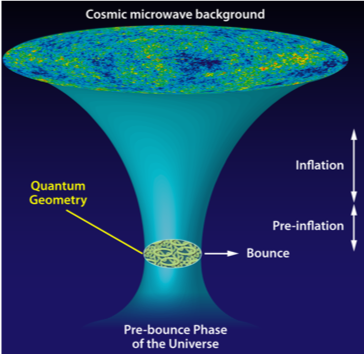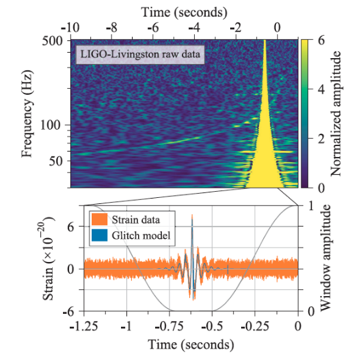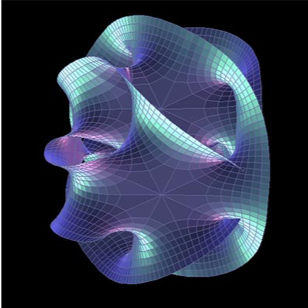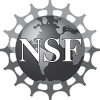Early Universe Cosmology & Superstrings
Two groups in CASPER conduct Early Universe Research:
- Early Universe Cosmology and Strings, (EUCOS) led by Dr. Gerald Cleaver and
- Gravity, Cosmology and Astroparticle Physics (GCAP) led by Dr. Anzhong Wang
Quantum Cosmology
One topic of active research in the EUCOS and GCAP groups is the investigation of quantum gravitational effects in the early Universe and their possible observations by current and forth-coming experiments. In particular, in the framework of Loop Quantum Cosmology (LQC), the big bang singularity is generically replaced by a non-singular quantum bounce, due to pure quantum geometric effects, from which the initial value problem of the inflationary universe may be resolved, and the evolution of the Universe can be determined from these unambiguous conditions. This multidisciplinary project has involved the GCAP director, Dr. Anzhong Wang, his graduate students, the EUCOS director, Dr. Gerald Cleaver, mathematics faculty Drs. Klaus Kirsten and Tim Sheng, and CASPER postdoctoral fellow, Dr. Bao-Fei Li. Recently, there have been various proposals to derive quantum cosmology directly from loop quantum gravity, and found some modifications to the standard LQC model. In collaboration with several international experts of the field, including Prof. G.A. Mena Marrugan from IEM-CSIC, Spain and Prof. P. Singh from LSU, Wang and his group members have been recently working on these modified LQC models.
Faculty & Staff: Anzhong Wang (head, Physics), Gerald Cleaver (Physics), Klaus Kirsten (Math), Bao-Fei Li (CASPER), Tim Sheng (Math), Yumei Wu (Physics)
Collaborators: G.A. Mena Marrugan (IEM-CSIC, Spain), P. Singh (LSU), Q. Wu and T. Zhu (ZJUT, China)
Background Literature
CASPER Papers
Gravitational Wave Astronomy
A second area of interest in the GCAP group is gravitational wave (GW) astronomy. A GW can be emitted by compact astrophysical objects, such as black holes and neutron stars. It can be also produced in the very early Universe, due to quantum fluctuations of space and time. The latter is often referred to as the primordial GWs. All the eleven GWs observed so far (September 11, 2019) were produced during the coalescences of two black holes or two neutron stars, and no primordial GWs have been observed, yet. Wang and his group members have been working on this field in the last couple of years, in collaboration with several international groups, including Prof. S. Mukoyama from Yukawa Institute for Theoretical Physics, Kyoto, Prof. W. Zhao from USTC, Hefei, and Prof. T. Zhu, from ZJUT, Hangzhou. Their main focuses currently are on the tests of gravitational theories of gravity by observations of gravitational waves from both astrophysical compact objects and the very early Universe. These include Einstein’s general relativity, Einstein-aether theory and scalar-tensor gravity.
Faculty & Staff: Anzhong Wang (head, Physics), Yumei Wu (Physics), Xiongjun Fang (visiting scholar, Physics)
Collaborators: Ronggen Cai (ITP, Beijing, China), Yungui Gong (HZUST, Wuhan, China), Jian Xin Lu (USTC, Hefei, China), S. Mukoyama (Kyoto U., Japan), N.O. Santos (Queen Mary U., London, UK), W. Zhao (USTC, China), Q. Wu and T. Zhu (ZJUT, China)
Background Literature
CASPER Papers
Superstring Theory
Research within the Early Universe Cosmology and Superstrings group within CASPER revolves around superstring theory, which unifies all forces in nature (gravity, electromagnetics, and the two nuclear forces). An enduring issue in string theory has been the discrepancy between the related SU(3)C x SU(2)L x U(1)Y gauge coupling unification scale, lU, for the MSSM with intermediate scale desert and the string scale, lH, for the weakly coupled heterotic string. When couplings are run upward from their low energy values near MZo, a MSSM unification scale lU ~ 2.5x1016 GeV is predicted for an intermediate scale desert. In contrast, the weakly coupled heterotic string scale is around lH ~ 5x1017 GeV. The near ubiquitous appearance in realistic string models of exotic MSSM-charged particles at an intermediate energy scale 100 GeV << lI < lU most often removes an MSSM unification scale separate from lH.
Faculty & Staff: Gerald Cleaver (head), Anzhong Wang.
Background Literature
CASPER Papers




